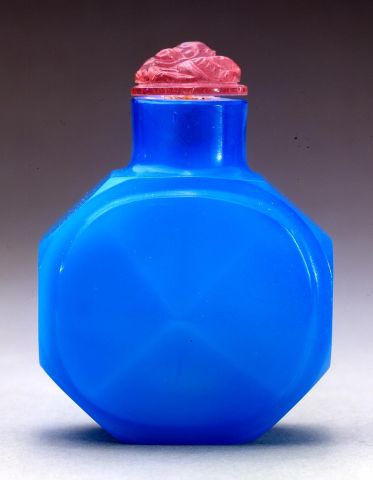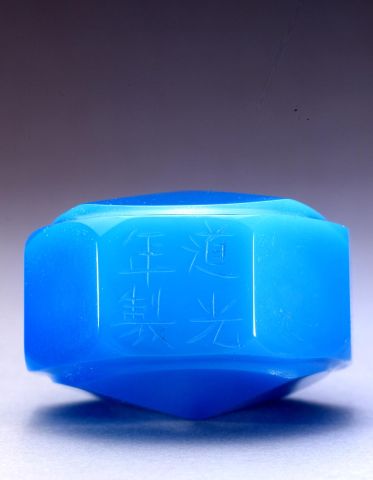

Bottle ID: 00303
TURQUOISE, SEMI-OPAQUE, OCTAGONAL W/RAISED PANELS
Date: 1821-1850
Height: 53 mm
Glass, semi-opaque turquoise tone clearing to a transparent vivid turquoise color at the neck, of octagonal faceted form, with raised quatrefoil panels on the main fascias, the neck with a wide mouth, the foot with a four character wheel-cut Daoguang nianzhi mark and of the period.
Imperial, attributed to the Palace Workshops, Beijing.
Similar Examples:
Kleiner, Robert. Chinese Snuff Bottles - The White Wings Collection, 1997, p. 70, no. 39.
Sotheby's, London, April 24, 1989, lot 295, Collection of Eric Young Part III.
Sotheby Parke Bernet (Hong Kong) Ltd., November 2nd, 1978, lot 58, The Arthur Gadsby Collection.
Provenance:
Clare Lawrence Ltd.
Alexander Brody
Clare Lawrence Ltd.
Joseph Baruch Silver
Robert Hall
Richard A. Bourne Co. Inc., Massachusetts, December 14, 1988, lot 219
Mrs. J. Gerald Mayer, no. 751
Exhibited:
Annual Convention ICSBS Toronto, October 2007
Published:
Lawrence, Clare. The Alexander Brody Collection of Chinese Snuff Bottles, 1995, p. 61, no. 86
Brody, Alexander. Old Wine into Old Bottles: A Collector's Commonplace Book, 1993, pp. 74 and 154
Hall, Robert. Chinese Snuff Bottles II, 1989, p. 72, no. 53
The traditional view has been that glass production went into decline after the eighteenth century and more or less came to a halt by 1860. However, contemporary researchers have challenged this view, putting forward a more balanced picture of continuous production until the advent of the Republic. Examples such as this, which are as high in quality as some of the earlier faceted glass bottles, support the latter viewpoint. This can be further emphasized by the small group of slightly larger rounded cobalt-blue glass bottles sporting Tongzhi nianzhi marks (see the bottle from the Arthur Gadsby Collection cited above). These two bottles also give credence to the idea that the Palace Workshops produced monochrome glass bottles which became larger in size as the centuries moved on. The reason for this is a point of conjecture unless it was simply due to the increased popular ity of snuff which made it less expensive and more frequently used.
< Back to full list
 English
English 中文
中文